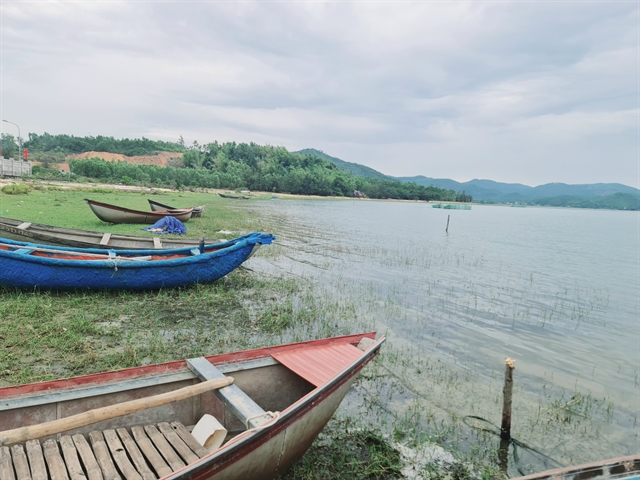
Fishing boats dock on the bank of An Khê Lagoon in Đức Phổ Town's Phổ Thạnh Ward of Quảng Ngãi Province. The lagoon is a core zone of the Sa Huỳnh Culture dating back 2,500 to 3,000 years. Photo courtesy of Lan Anh
Công Thành
Conservationists, archaeologists and historians agree that An Khê Lagoon in the central province of Quảng Ngãi must be conserved -- as a key part of the Sa Huỳnh Culture -- rather than being developed with two solar farms.
Members of the National Cultural Heritage Council stated at the review conference on the possible development of two solar power projects in early July that the province's authorities should allocate a separate area for the two solar power farms rather than building on the lagoon.
They said the development of the projects would violate the heritage law issued in 2009, and an amendment in 2011, as the 347ha lagoon was included in the dossier of the Sa Huỳnh national special heritage site for approval by the council in 2015.
The plan for the two solar power projects is seen as a barrier to the council approving the special national heritage site of the Sa Huỳnh Complex, though the document preparation process began five years ago.
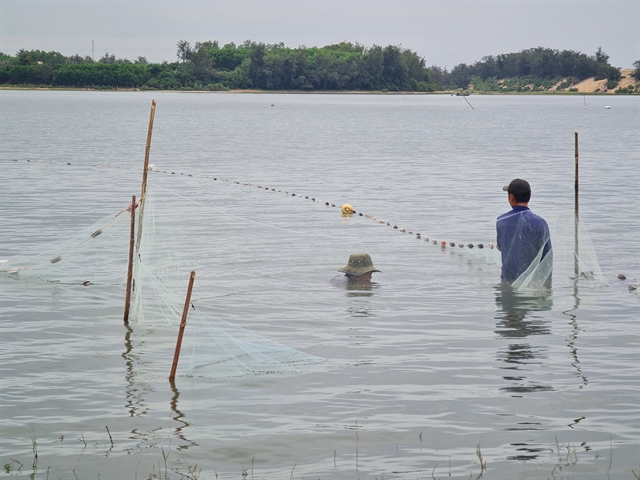
A local man net fishes in the water of An Khê Lagoon. It's one of 12 central coastal lagoons from Thừa Thiên Huế to Ninh Thuận provinces. The lagoon has been included in the dossier on the national special heritage. Photo courtesy of Lan Anh
Solar farms
The proposal for the development of the two solar farms – which will be built by the Systech joint-stock company and received agreement from the province's authorities in 2017 – covers 66.7ha, of which 65ha is water surface (19 per cent of the lagoon), with an investment of VNĐ1.96 trillion (US$85.3 million) for full operation in late 2024.
Bùi Chí Hoàng, a member of the National Heritage Council of Việt Nam, said the 347ha-lagoon played a key role in the community's livelihood and served as a conservation base of the ancient Sa Huỳnh Culture, dating back 2,500 to 3,000 years.
"Two solar power farms will not be sustainable as solar cells need complicated treatment for years, while it affects the aquaculture and fishing trade of local people as well as damaging the untouched natural landscape," Hoàng said at a conference on the impact of the solar power farms in July.
"An Khê Lagoon is a base for sustainable development on the Sa Huỳnh Culture complex, including the new Gò Cỏ eco-tour village, Sa Huỳnh salt fields, and the exhibition centre of antiquities of the Sa Huỳnh culture that was first excavated by archaeologists more than 100 years ago."
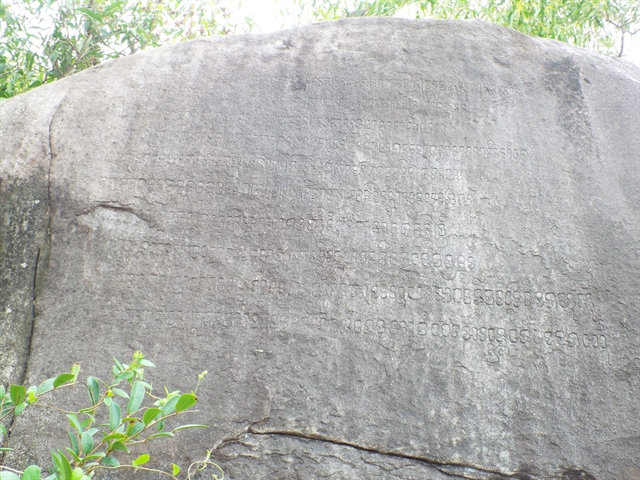
A rock with ancient Chăm scripts is found near An Khê Lagoon in Phổ Thạnh Ward in Quảng Ngãi Province. The area still has reserved unknown relics from Sa Huỳnh Culture. Photo courtesy of Nguyễn Kiều
Hoàng said the province should build an eco-tour zone for community-based tourism and research on the Sa Huỳnh Culture rather than allowing two solar farms in the core zone of this unique heritage.
The Chairman of the National Heritage Council of Việt Nam, Lưu Trần Tiêu, said the council had urged the provincial authorities not to approve the solar power farm projects on the lagoon in 2019 after a field survey by a group of archaeologists and scientists.
"Solar power projects can be developed at different places, but relics of heritage will disappear forever if we do not preserve them," Tiêu said.
"The lagoon must be conserved and protected by the Law of Heritage of Việt Nam as it is deemed to be a UNESCO world heritage site in the near future."
In considering the development of renewable projects, the provincial authorities held a meeting among local departments and investors of the solar power projects on April 15.
Many at the meeting said the two solar farm projects were not in line with the master plan for development of Đức Phổ Township, and the projects were not yet included in the National Electric Power Plan (2021-35).
At the meeting, Trần Hoàng Tuấn, vice chairman of the provincial People's Committee (administration), decided to halt the solar power projects for further scrutiny by local authorities and investors, but the province then sent an official document to the Ministry of Industry and Trade asking to add the two solar power projects in the National Electric Power Plan on April 19, four days after the meeting.
Phạm Quốc Quân from the National Heritage Council of Việt Nam explained that a dossier on the Sa Huỳnh complex to apply for national special heritage site status was prepared by the culture authority of Quảng Ngãi Province in 2015.
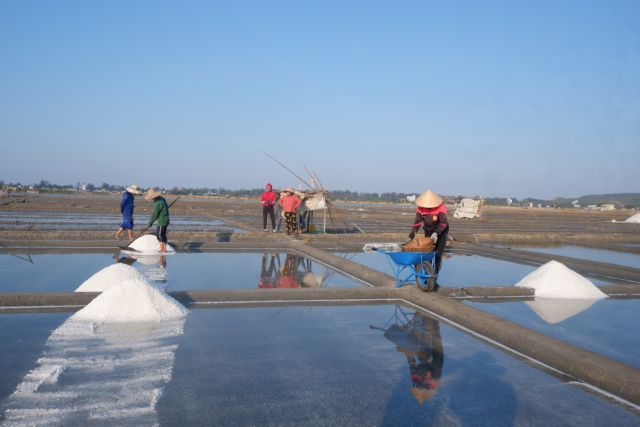
Local farmers work on Sa Huỳnh salt fields in Đức Phổ Town. Urbanisation has claimed farmlands in the agriculture-intensive region of Quảng Ngãi Province. Photo courtesy of Sahu
Heritage
He said the separation of the lagoon from the heritage dossier by the provincial authorities had postponed the approval of the special heritage site status for the Sa Huỳnh Culture complex.
"The council asked the province to expand the protection area for the heritage site that includes the lagoon, but the provincial People's Committee has not yet made any adjustments to the dossier," Quân said.
"This means the lagoon must be kept intact and protected as a key part of the heritage site and not reserved for solar power projects."
The Chairman of the Việt Nam Archaeology Council, Tống Trung Tín, said that An Khê Lagoon was a living space for local residents and part of the Sa Huỳnh Culture.
He said there was no other lagoon with a similar ancient cultural and archaeological value anywhere in the world.
Đoàn Ngọc Khôi, a historian from Quảng Ngãi Museum, said the dossier on the Sa Huỳnh national special heritage site had been compiled in 2015, but the plan to develop two renewable energy projects had delayed the process of recognition.
Khôi said the approval of the special heritage site would be completely finished if the province commits to preserving the lagoon and Sa Huỳnh Culture, meaning that the area for two solar power projects must be built at another place, not in the lagoon area.
Lê Tấn Chuẩn, a local resident in Đức Phổ town, said the lagoon had been the breadwinner of thousands of farmers for centuries.
He said developing the two solar projects would be bad for heritage while damaging the environment, natural landscape and livelihoods.
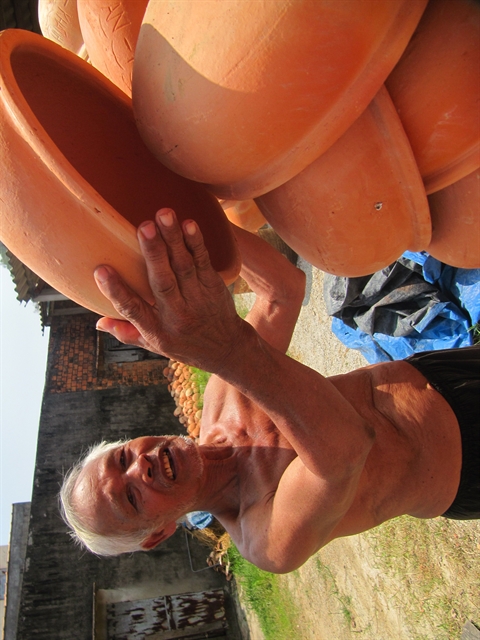
An elderly artisan dries baked ceramic pots in Đức Phổ Town of Quảng Ngãi Province. The craft has been preserved for community-based tourism in connection with exploring tours on the Sa Huỳnh Culture complex. VNS Photo Công Thành
Trần Văn Trung, 60, a local farmer, said the lagoon had been a major fishing ground of local people for generations, while the development of solar power projects was not wanted.
Võ Văn Minh, from Đà Nẵng University of Education and Science, said An Khê Lagoon is one of 12 lagoons along the central coastal region from Thừa Thiên Huế to Ninh Thuận provinces.
Minh suggested that the lagoon should be developed for community-based tourism with shared management of state agencies and the community.
"The lagoon could be linked to a biosphere reserve plan that covers an area of 537,000ha ranging from Quảng Ngãi City to Sa Huỳnh for the sustainable development plan and biodiversity protection," he said.
In 2021, local authorities ended all activities related to the UNESCO recognition of the Lý Sơn-Sa Huỳnh Global Geo-Park (covering an area of 4,600sq.km, including more than 2,000sq.km of sea, covering nine districts and islands for global geopark recognition), and An Khê Lagoon is part of the park.
The provincial People's Committee stated the park would be used for various socio-economic development purposes and suspended all field activities on the park's file completion process and scientific research.
An Khê Lagoon, which is 3.5km long and 1km wide, is rich in biodiversity with 35 aquatic species. It connects to the sea via a 3km inlet.
The lagoon is believed to have formed during the Flandrian interglacial period (from 6,000 to 7,000 years ago).
French archaeologists excavated the site to find artefacts from the Sa Huỳnh Culture in 1909, but the bottom of An Khê Lagoon has not had any archaeological excavation since.
Quảng Ngãi has developed 28 solar power projects with a total capacity of 27MWp and 581 household roof-top solar power projects (7.2MWp). VNS
OVietnam